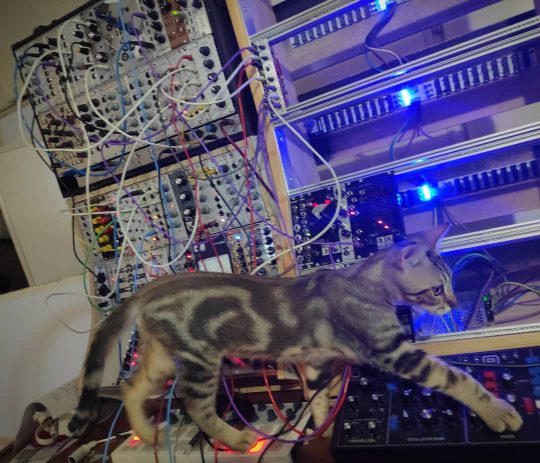
Max, with his lovely marble markings, explores the studio. He is walking past an impressive collection of Eurorack modules, stepping on an Arturia BeatStep, and about to tweak some patches on the Behringer Model D. From coresect23 on Instagram.


Max, with his lovely marble markings, explores the studio. He is walking past an impressive collection of Eurorack modules, stepping on an Arturia BeatStep, and about to tweak some patches on the Behringer Model D. From coresect23 on Instagram.
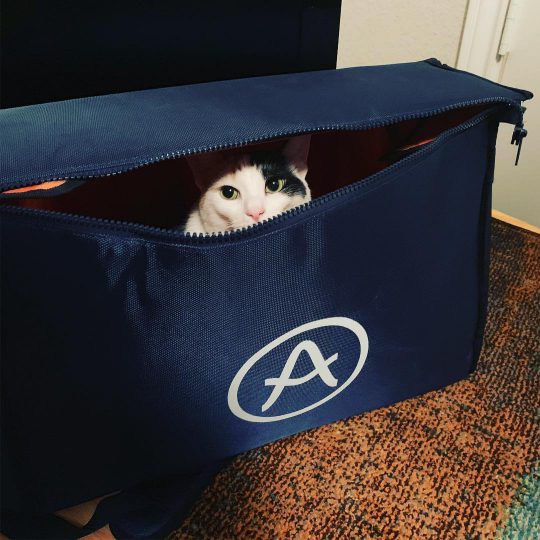
A black-and-white cat plays hide and seek in an Arturia gig bag. From particlesintowaves on Instagram.
We have the exact same back here at HQ for our Arturia MiniBrute 2 and RackBrute 3U. It makes gigging with that instrument very easy. But I hope neither Sam Sam nor Big Merp decides to make it a hiding place…
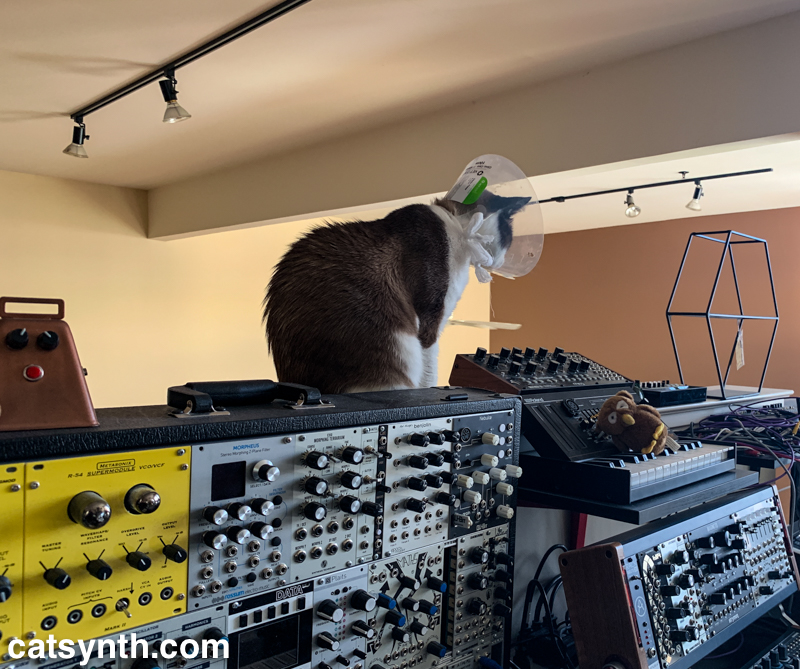
Big Merp jumps up on the ledge behind the modular synths (the main system as well as the RackBrute). Also present are the Deptronics Thunderbell, Moog Mother 32, Roland Boutique VP-03 (with owl), and the Korg Volca Beats.
Poor Merp has had to wear the cone of shame since his surgery on Friday, but as this picture shows, by Wednesday he was feeling much better and back to his regular mischievous self. So we decided to liberate him from the cone.
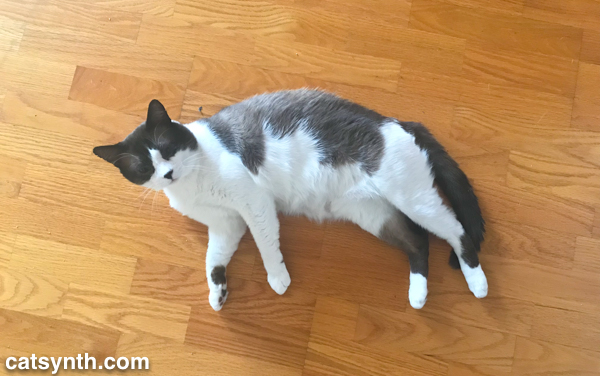
He seems much happier without it 😸
I have attended the Garden of Memory at the Chapel of the Chimes in Oakland many a summer solstice since moving to San Francisco – and written multiple reviews on these pages and even presented a CatSynth TV showcase last hear. But 2019 is the first time I have performed at this annual event as a named artist. It’s a very different experience from the inside looking out. This article describes the adventure.
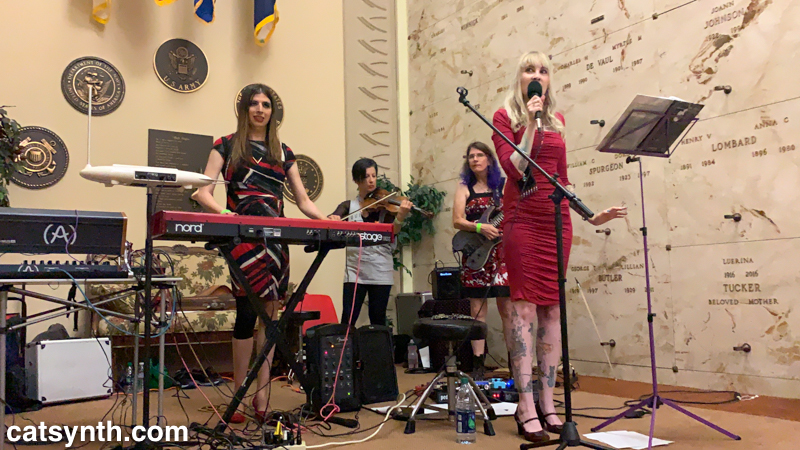
My friend and sometime collaborator Serena Toxicat and I were excited to be accepted into this years program for our project Manul Override. We joined forces once again with Melne Murphy on guitar and also invited Thea Farhadian to sit in with us on violin.
I had a rather elaborate setup, anchored as usual by my trusty Nord Stage EX. The Sequential Prophet 12 has also become a mainstay of my smaller collaborations, providing rich ambient sounds. The Arturia MiniBrute 2, Moog Theremini, and a collection of Eurorack modules rounded out the rig.
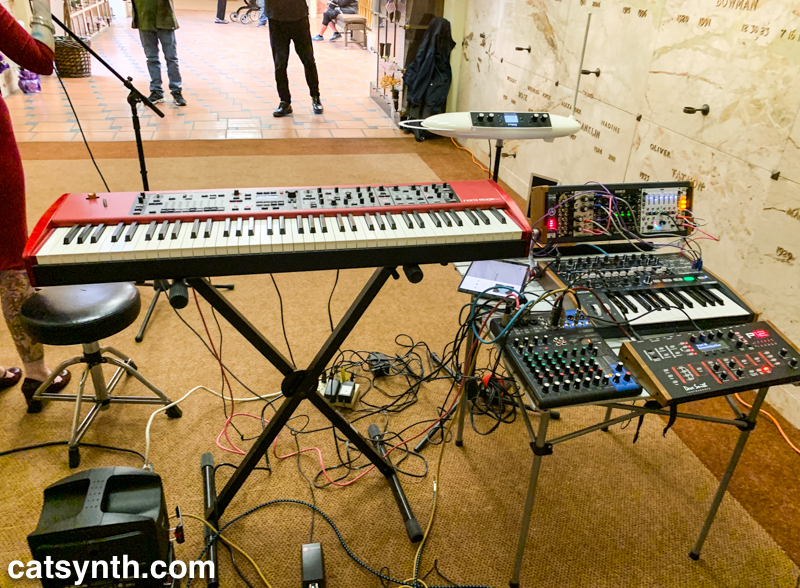
Getting everything into place in the catacombs-like building – a renowned landmark designed by Julia Morgan – was a challenge in itself. Fortunately, I found parking nearby and was able to load everything onto carts or wheeled cases, and had plenty of help getting things downstairs where we were playing.
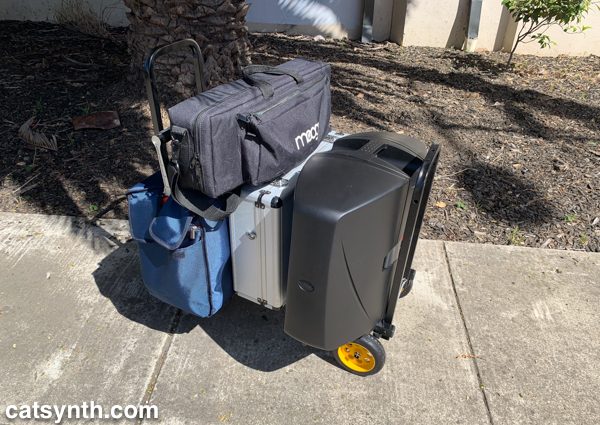
The acoustics of the space are also quite challenging. It is a set of oddly shaped stone chambers, some large, some small, so echoes abound from both the crowds and other performers. Figuring out how to balance our sound is not easy, and I don’t pretend to have gotten it right on the first try, but it’s a learning experience. But we did get ourselves sorted out and ready to play.
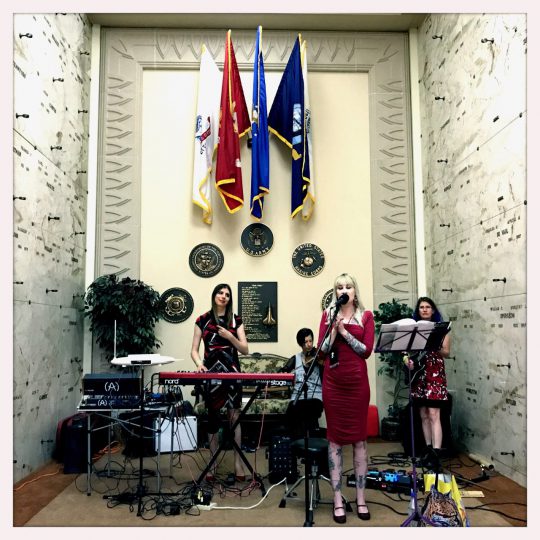
The set unfolded with an invocation, a drone in D mixolydian mode set to Serena’s text Mau Bast, read first in French and then in English. It seemed a perfect piece for the occasion. We then switched things up with a more humorous piece (Let’s Hear it for) Kitties, which was a crowd favorite. You can hear a bit of it in this video from the event.
I have learned how to best follow Serena’s style of speaking and singing, with a more open quality; and Melne and I know how to work together well both in terms of timing and timbre. Thea’s violin added an interesting counterpoint to the voice and electronics. Her sound was sometimes masked by the other instruments and the acoustics but when it came through it added a distinct character and texture. The remaining two pieces were more improvised. One was a free improvisation against one of Serena’s books Consciousness is a Catfish, and another was based on a graphical score with 16 symbols that I first created in 2010 but have revised and reused over the use. The newest version included a cartoon pigeon in honor of my bird-loving co-conspirator Melne.
The performance was well received. Crowds came and went throughout the evening, but many people stayed for extended periods of time to watch us, and others came back a few times. We played two hour-long sets, and in between I had a small amount of time to check out some of the other performs. In particular, I enjoyed hearing Kevin Robinson’s trio, with whom we shared our section of the space.
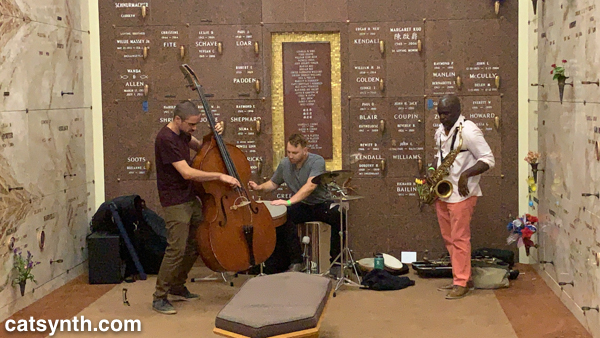
His spare group and arrangements with saxophone, upright bass, and drum, provided a distinct contrast to our thick sound. The moved between long drawn-out tones and fast runs with short notes that reverberated around the space in between. Robinson’s music often has a meditative quality, even when it is more energetic, so it fit well.
Around the corner from us was the Stanford Laptop Orchestra (SLOrk). They had a quiet set featuring performs seated on meditation cushions with laptops as well as various percussive objects as sound sources.
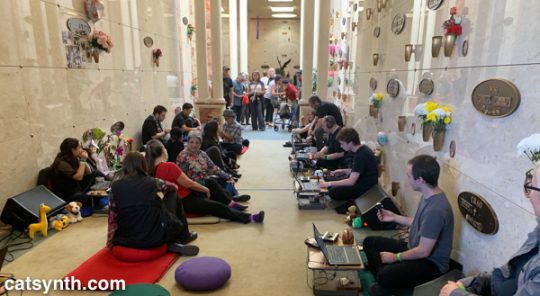
I was particularly inspired by Anne Hege and her Tape Machine, an instrument with a free-moving magnetic tape and several heads, pickups and tiny speakers. She sang into it at various points and moved the tape, created an instrumental piece that was part DIY-punk, part futuristic, and somehow quite traditional at the same time.
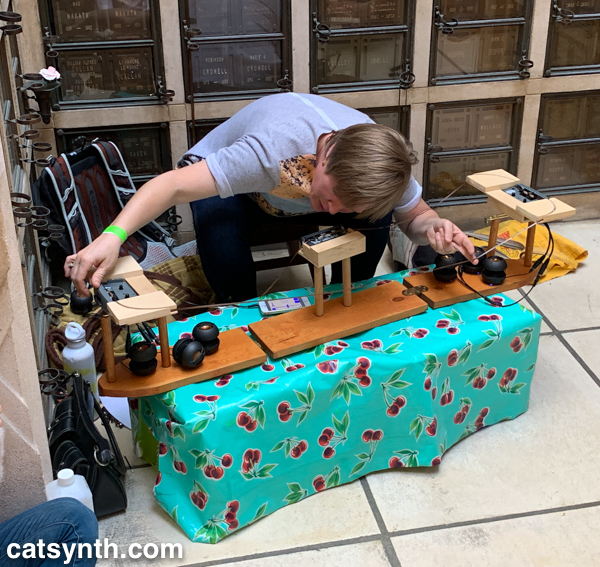
Her performance gave me ideas of a future installation, perhaps even to bring to the Garden of Memory in years to come…
Thea pulled double duty during the evening, also performing as part of a duo with Dean Santomieri, sharing a space with Pamela Z. Our friends Gino Robair and Tom Djll brought the duo Unpopular Electronics to one of the darker columbariums, and IMA (Nava Dunkelman and Amma Arteria) performed on the lower level. In retrospect, our group might have been better placed sharing a space with them, as we are both electronic groups (all women) with large dynamic range.
Overall, it was a wonderful experience, and with the opportunity to play as well as listen it’s my favorite to date. Thank you Sarah Cahill, Lucy Mattingly, and the rest of the crew at New Music Bay Area as well as the Chapel of the Chimes staff for letting us be a part of this event!
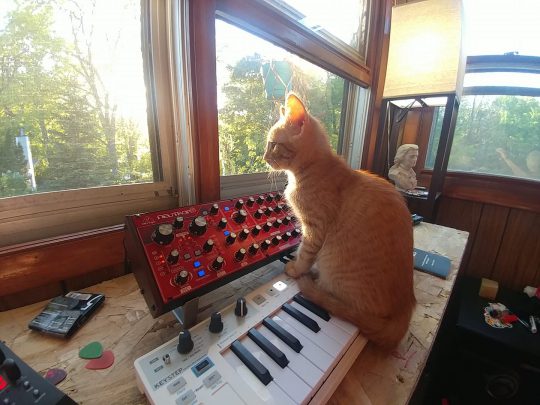
A pretty orange tabby plays some notes on an Arturia Keystep and Behringer Neutron synthesizer. From Karl Garcia via Facebook.
In the middle of a patch this cat just sits down on the keyboard and gets the arpeggiator going lol.
Of all the synthesizers in Behringer’s growing catalog, the Neutron is one of the two that most interests me personally, the other being the new VC340 Vocoder. You can see my encounter with Behringer’s synths before NAMM in this video.
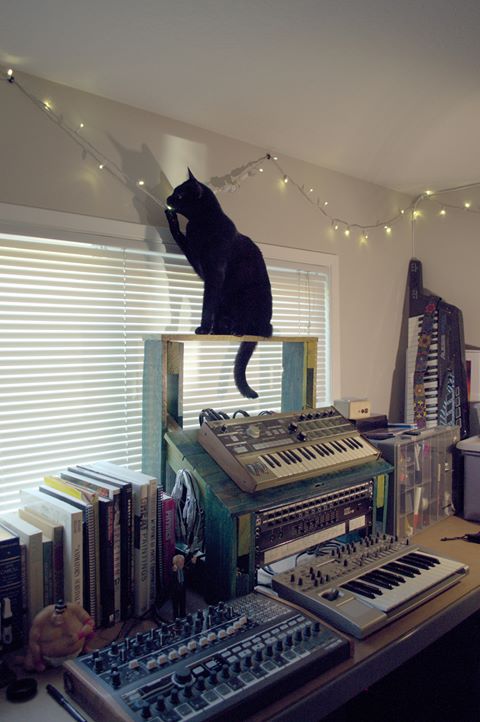
Meet Numbers the black cat. He sits on a custom synthesizer rack made from recycled wood that houses an Arturia MiniBrute 2S, Novation keyboard, and a MicroKorg. From Sam Brubaker via our Facebook page.
A photo of my cat, Numbers. Here he is inspecting the room lighting while sitting on a synth rack I built out of recycled wood from a shipping palette.
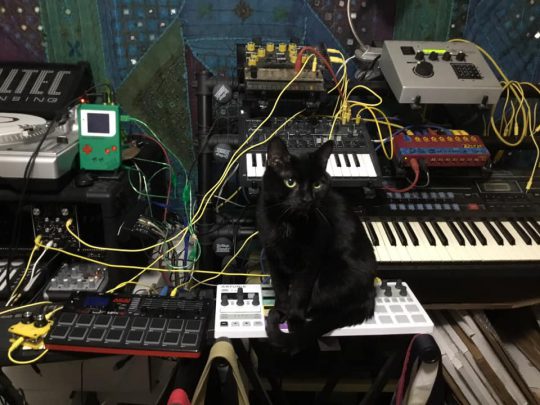
A gorgeous house panther shows off her studio, which includes a MicroBrute and controllers from Arturia, an Elektron SidStation, and a Nintendo GameBoy. From Shaun Steven Struble on Facebook, who says this about the GameBoy:
My main composition machine. If I can write it in three voices on the gameboy and it sounds good, I know it’ll sound good when I expand it to the other synths.
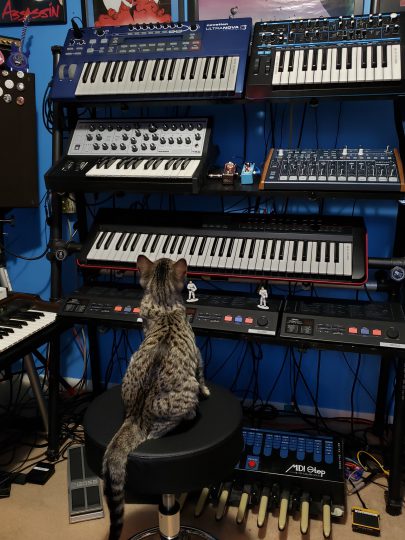
Nepal sits in the studio ready to compose a magnum opus on an impressive collection of synths including a Moog Sub Phatty, Arturia MiniBrute 2S, multiple Novation instruments, and several vintage Yamaha boxes with that cool diagonal front panel. Submitted by Brian T Geigner via our Facebook page.
Nepal composing a new song.
We can’t wait to hear what Nepal comes up with 😻🎹
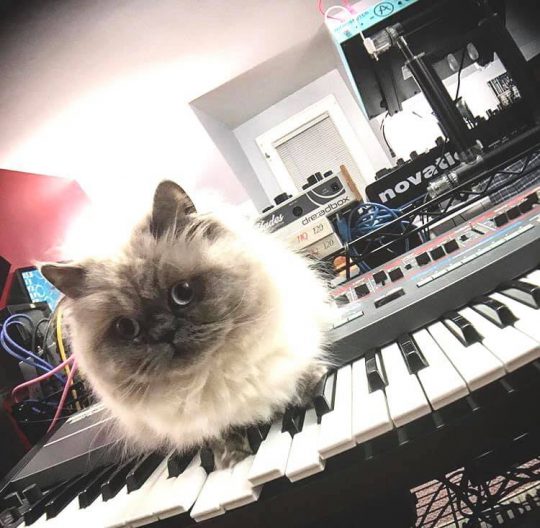
Scout sits atop a vintage Roland synthesizer. We are pretty sure it’s a Roland Juno 106. In the back, we see a Dreadbox Hades, as well as offerings from Novation and Arturia. From Carl Peczynski via our Facebook page.
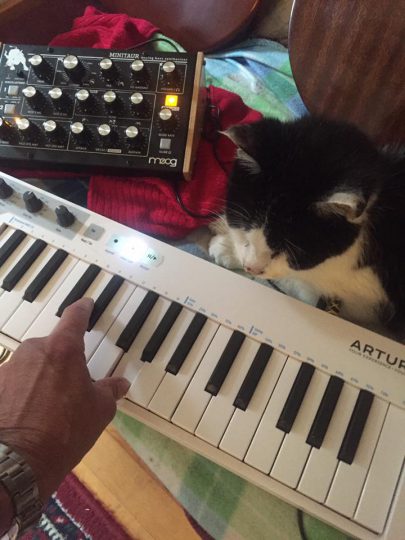
Mojo the cat looks on as a musical performance with an Arturia Keystep and Moog Minitaur unfolds. He seems to quite enjoy it. Submitted by Bruce Oliver via our Facebook page.
Mojo was my little buddy for 17 years. He loved synth sounds but would vacate the room if you picked up a guitar!